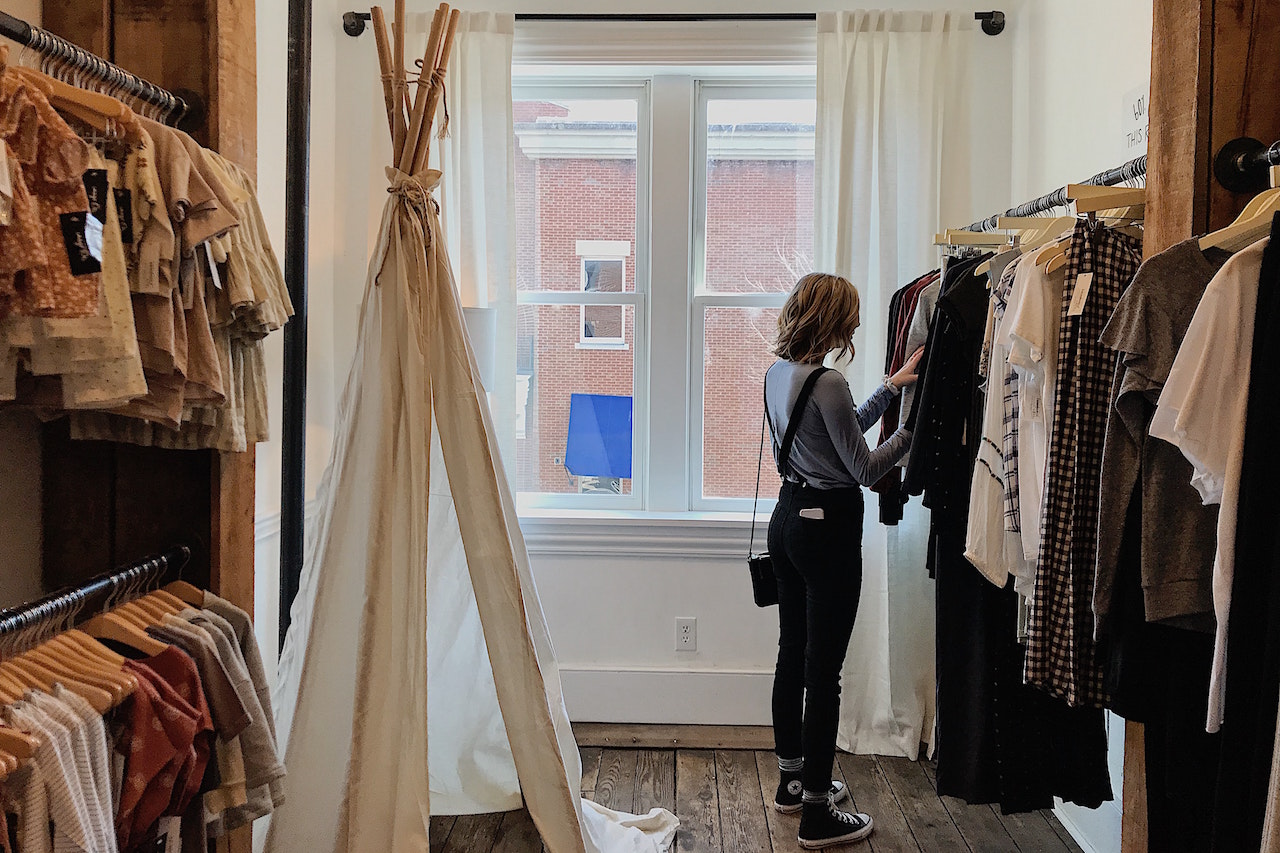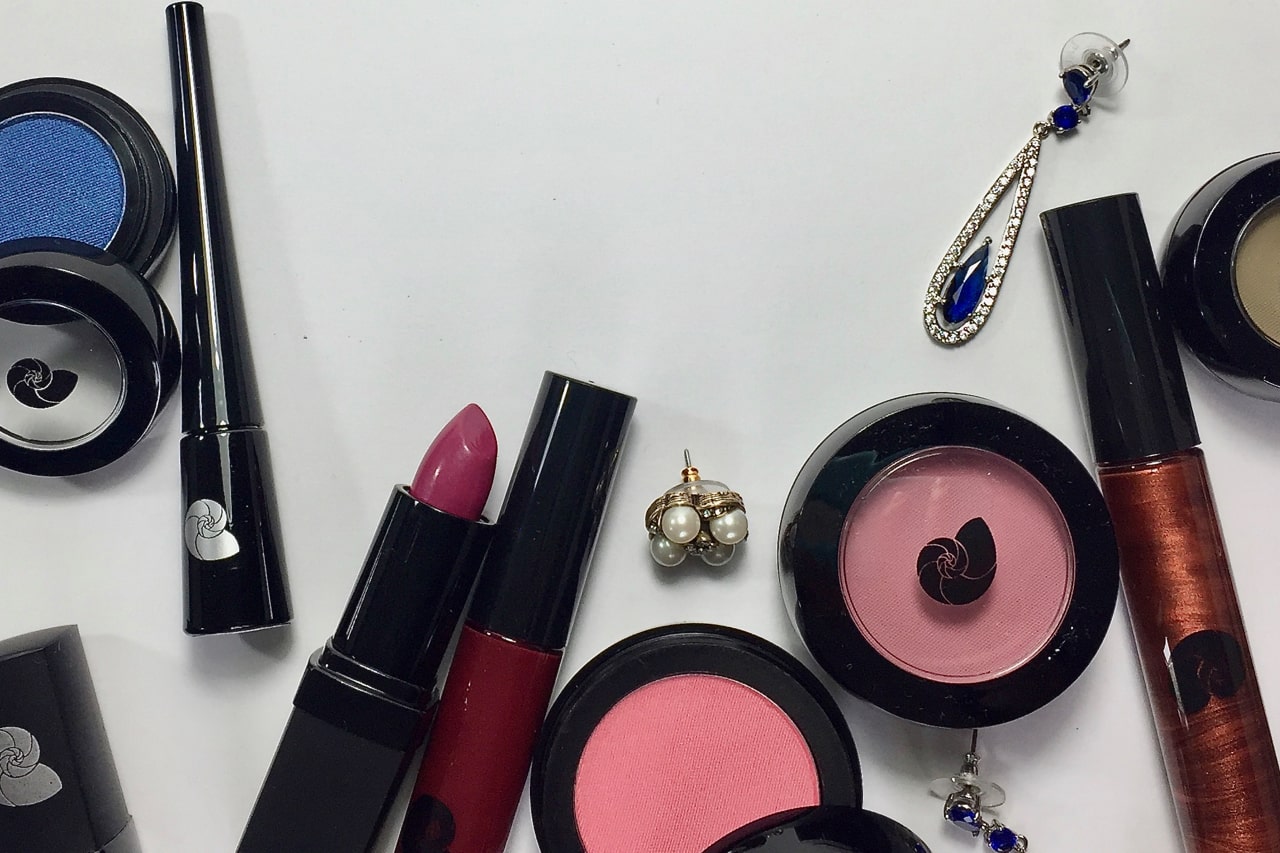by Rachel Nachmias (Pennsylvania)
On a recent call, one of my beautiful clients showed a top which I suggested looked a bit too light and soft and hence, might not fit into Dark Winter as presumed. She replied that she had checked it with the fan and here’s what it looked like:
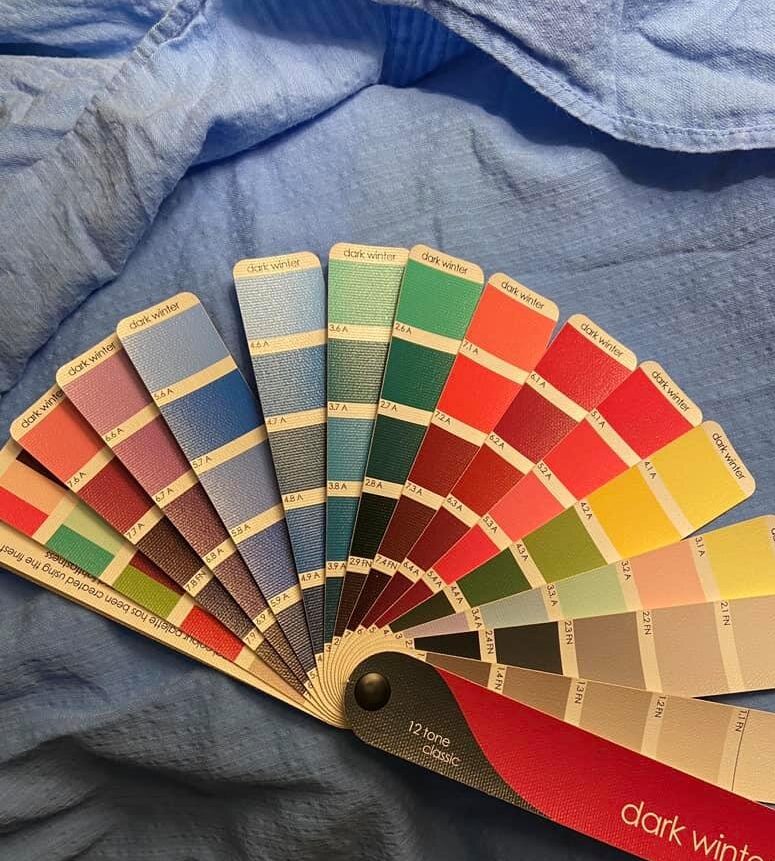
Is this a match?
I would bet good money that if you showed this to almost anyone, including me before I was trained as an analyst, they would say this certainly looks like a match to 4.6A and/or 5.6A. No, it’s not a perfectly lit picture but it actually doesn’t have to be to make the point. For me, I can see well enough to suggest some possible issues with this top, largely because I’m not actually looking for a match.
If you just went “what the whaaat?”, hang with me while I explain. At my color analyst training, one of the most important things I learned is that human eyes don’t see objectively, they see subjectively – meaning that unlike say, a computer when we look at a color, we judge it based on comparison, not based on the objective truth of the color. In fact, we’re pretty much incapable of the latter, because of the way our vision system is set up. What this means is that some of the most adept eyes for color in the world, still aren’t very good at what most of us would call “matching” color – i.e. holding one color next to another and judging if they’re the same.
It may seem, given this revelation on matching, that we’re doomed never to be able to tell whether we’re looking at a palette color or not. Fret not friends, as this is actually good news! Not only are you likely not very good at matching, but you also don’t need to be. The secret to finding your seasons color lies in a process we 12 Blueprints analysts refer to as “harmonizing”, which can be defined as using the fan as a measuring stick for the color qualities your season is based upon, NOT as a list of colors you can wear.
Harmonizing not matching
Harmonizing will not only allow you to tap into the strengths of your human eyes and make it much easier (after a bit of practice!) to identify your season’s colors, but it also opens up a universe of options beyond the 65 colors printed on your palette. Our eyes can see millions of colors, and every one of them can be defined by the same color qualities that define the 12 seasons in the 12 Blueprints system of Color Analysis. This means that the number of colors in your season is roughly millions divided by 12, a lot more than 65. Yes, movements between colors can be extremely minute, and most colors that fit your season (though definitely not all!) will bear a strong resemblance to a swatch on your palette. But they absolutely, categorically do NOT need to be exact matches.
How the color fits in
Before you run off and interpret the above as “close enough is good enough”, let me just make it clear that sometimes it is and sometimes it most definitely is not. We’re not good at judging how close a color is to another color, so we’re not going to make decisions based on that at all. Instead, we’re going to seek to identify how the color in question fits with the whole palette. Let’s look at some examples.
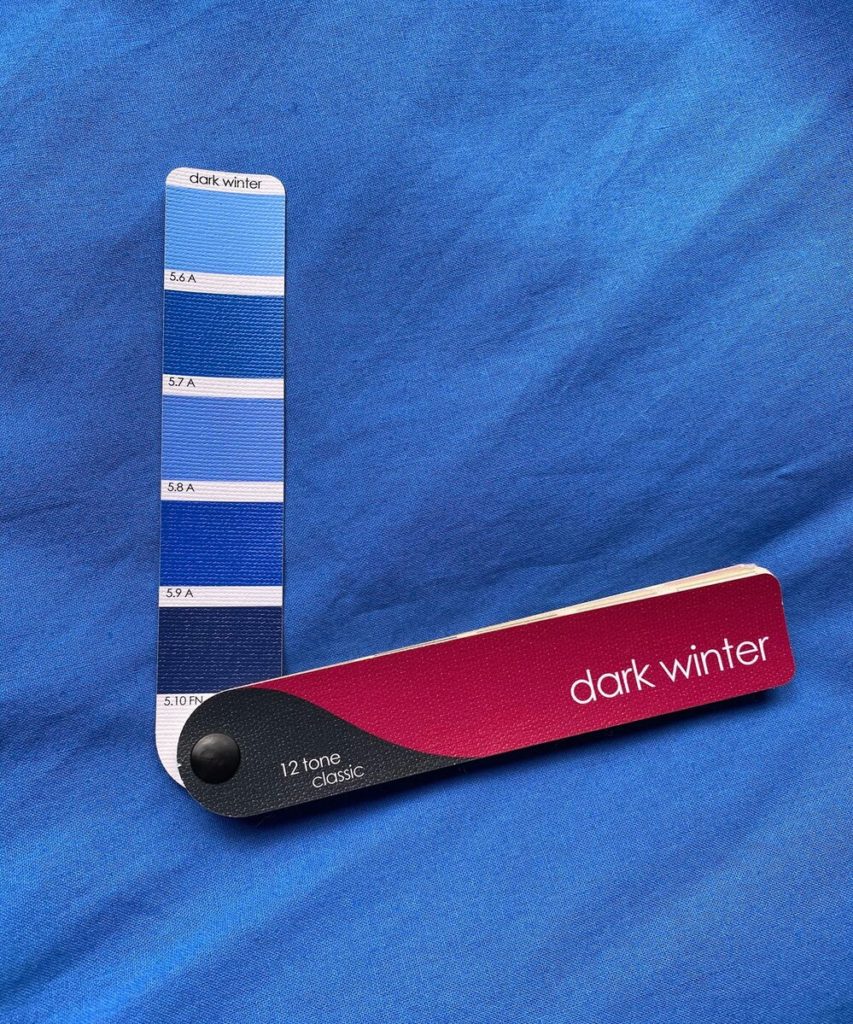
Here, we have a blue drape from my analyst kit in a similar range to the one my client was looking at (obviously it’s darker, but as you’ll see in a moment, it has a very similar relationship to the dark winter fan as the one she was testing). I’m cheating somewhat, as I already know what season this drape is, but more to the point I think most people would look at this image and feel it’s a fan match. For me as well, it’s hard to say whether it is or not if this is all I have to go on. I start to feel frustrated looking at it… my brain wants to shout “I’m not a wizard! How should I know?” Well, yeah, that’s pretty much how it feels to try to analyze color with one hand tied behind your back. So let’s make it WAY easier, shall we?
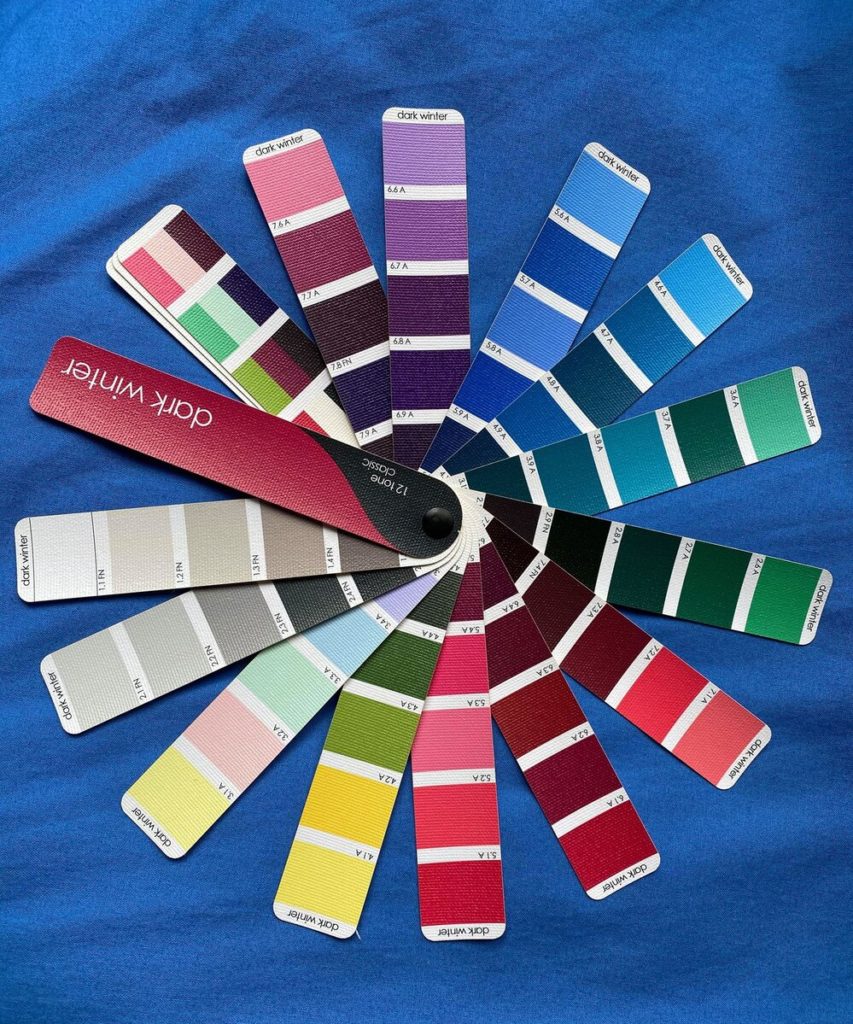
The steps
If you want to make life working with your palette easier for yourself, I suggest you start examining each new potential purchase as shown above. Make as much space between the branches as possible, so that ideally you can see most of the fan colors resting against the fabric. The eye will want to go to the blues, or whatever color is most similar to the fabric being tested. Try to back up and see how the fan as a whole is balancing with the fabric (as a tip, you can hide the colors similar to the fabric to help you see the whole picture better and avoid getting sucked into a particular swatch).
Next, ask yourself, with as much open-ended curiosity as possible, knowing that this is just information and not a decision on whether to keep/toss/wear/buy the item or not (a separate question for another day), what do I notice? Are the fan and the fabric equally weighted? Are the colors of the fan beautiful with the fabric? Does everything just seem to “fit” or are the colors or portions of the fan that seem out of place? For me, the feeling of a fan on a fabric in perfect harmony is something like one of those oddly satisfying videos, where an object fits absolutely perfectly into a space that’s just the right size.
What can we see?
As I look at the above image, the first thing I notice is that much as I try to see the whole picture at once, my eye keeps wanting to drag back to the hot pinks, corals, and yellows of the fan. Not only do this handful of fan colors seem distractingly strong, but the blue fabric also seems somewhat faded when I glance over to it at the side of these particular swatches. As my eye wanders, I notice almost none of the reds are particularly beautiful here, and many look heavy and muddy. The darkest reds look nearly black and would likely look pretty gothic as lipstick with this color if they were worn together. The more I look, the more inconsistencies I find. The yellows look almost like highlighter colors, and I know they’re not even the brightest yellows on any fan. The warmest greens are almost nauseating. The warmer greys look dirty. The strip of color combinations looks awkward and disjointed. And as it happens, I see very similar effects in my client’s image of her top I showed previously. So while they may not be the same color, they react to the Dark Winter fan in a similar way.
Break the problem into smaller bites
If it’s hard for you to see what I’m describing, don’t give up just yet. While looking at the whole fan at once can be an invaluable tool, it can also be a little TMI – just too much information to take in at once. This is especially true for beginner harmonizers, but sometimes I still find myself overwhelmed. Fortunately, we can break the problem down into smaller bites without reverting to attempts at “matching” by breaking down the fan into smaller chunks. The idea is to look at just a few strips at a time, just NOT the ones that are closest to the item you’re examining. Here is the same fabric the season’s red colors (which I often refer to as “the lipsticks”), as well as the greens, which as my mentor Christine Scaman has said, are usually either great (because they harmonize) or gross (because the wrong green is pretty yuck). I often use just the neutrals or just the strip of color combinations on its own, but really anything that helps to approach the problem in smaller bites can be very helpful.
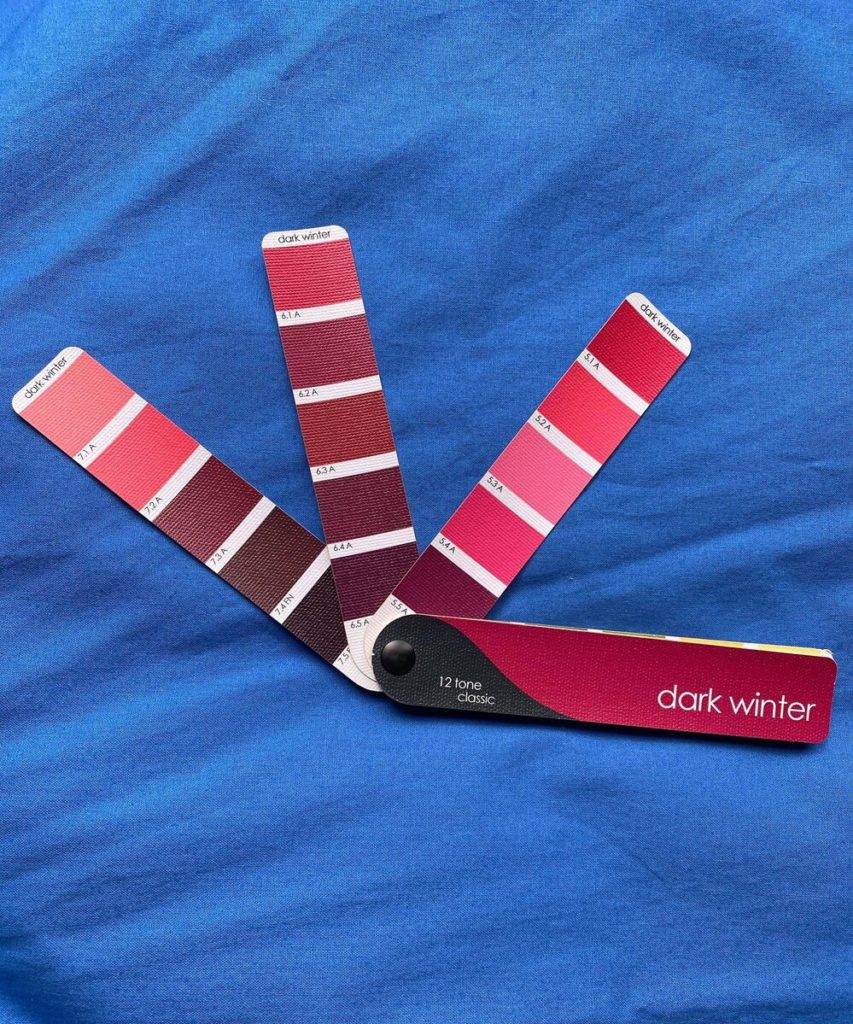
Looking at the lipsticks alone, I can see that almost none of them truly work. The brighter shades are blinding, while the darker shades are too heavy, hard, and dark to be a mouth color next to this top.
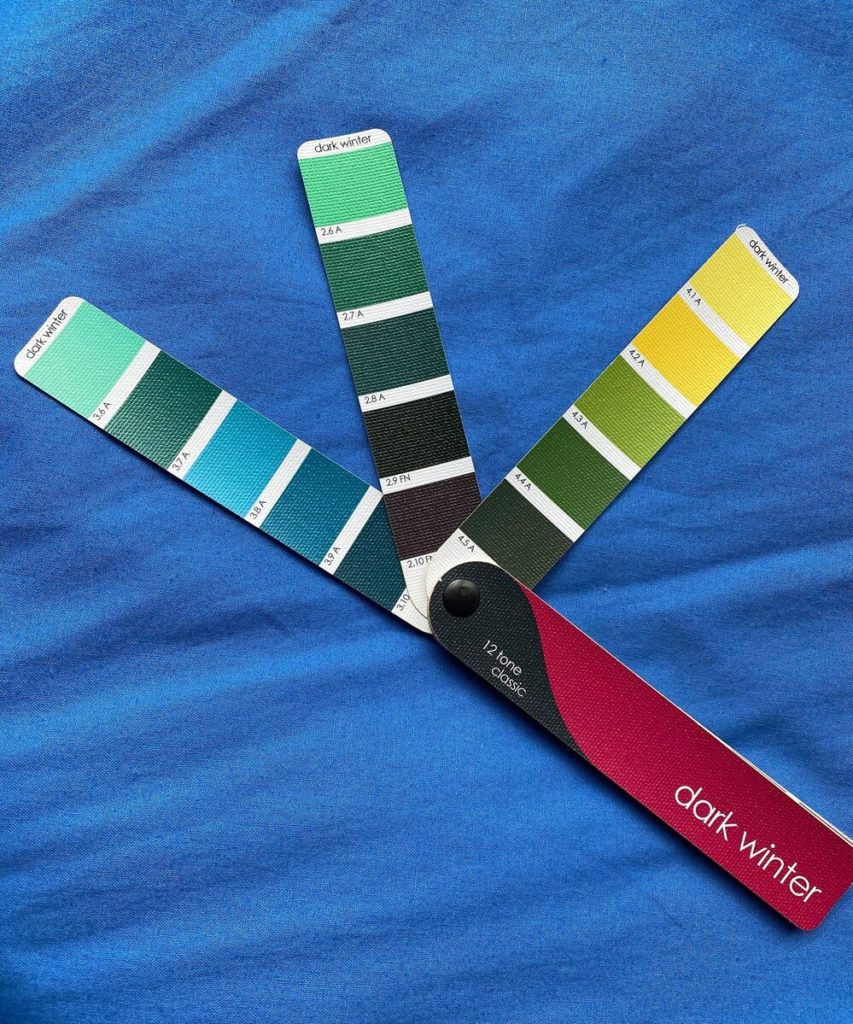
The greens present similar issues – only the coolest, bluest colors here look particularly nice next to this blue. The olivey-yellow greens look nauseating, and even the lightest greens are too sharp next to this blue. If I didn’t already know, I wouldn’t have enough evidence to say what season this fabric is. That’s ok because unlike if I were swatching this fabric to use as a drape in a Color Analysis, here, I only need to know one thing – Is this Dark Winter, or isn’t it? And I do have enough evidence to say it likely isn’t.
To reiterate, this isn’t enough information to know what to do with this item. A wide variety of other factors must be weighed in that decision. It’s best to approach harmonizing as a separate step, something akin to trying a garment on to check the fit or checking the tag to see the fiber content and care instructions. By doing so, you can move into the decision making phase with the most objective, clear information possible.
Other examples
With practice harmonizing many items will be easy and straightforward, finished in seconds upon placing your fan down. Other examples, like the one we’ve been exploring, are not as obvious or straightforward. In case it might still not clear to you why this blue doesn’t fit, let’s look at a couple more examples. Dark Winters often find it a struggle to locate their more medium and light value colors apart from white, but also understand that they need contrast to create the most effective, “in-focus” picture. So here we have a blue of similar value (albeit more greenish) which does fit with the palette.

I don’t know about you, but for me when I look at this picture, the energy is electric. The fan looks balanced with itself, and also with the fabric, and I can see the whole picture at once without it fragmenting. Even the unexpected combinations are beautiful and would be gripping in an unexpected, artistic print together. The deeper, warmer colors look rich but not dirty, the bright colors look vibrant but not glaring, and the neutrals look crisp, clear, and sophisticated. The fabric isn’t an exact match to any swatch, though it resembles some, and it doesn’t need to be. Go back to the image of the previous blue with the fan – can you see the difference?
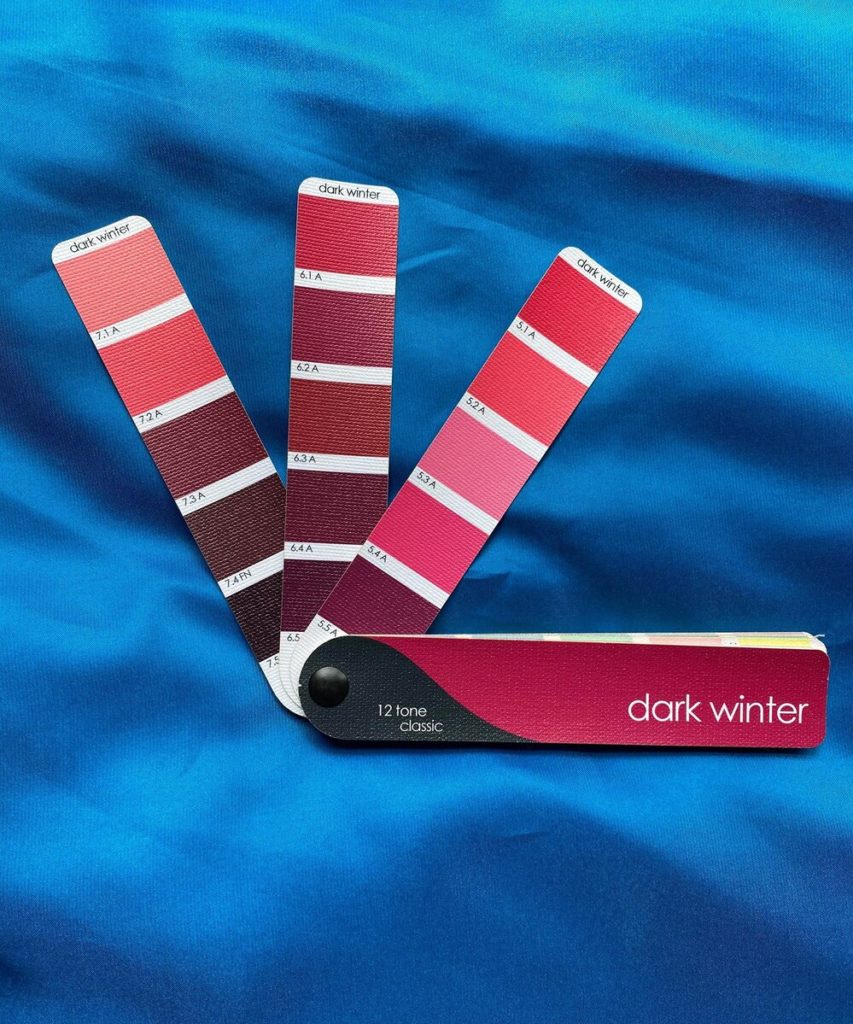
Here’s the same breakdown we did before with smaller chunks of the fan. The lipsticks are balanced, the bright options stay manageable and even the darkest swatch looks intriguing and not heavy or like a black hole. The corals, a decent approximation of a complementary color for this fabric, are heart-stoppingly pretty. If this is the woman, I see her and I see her lips and I’m not distracted, but rather want to know more.
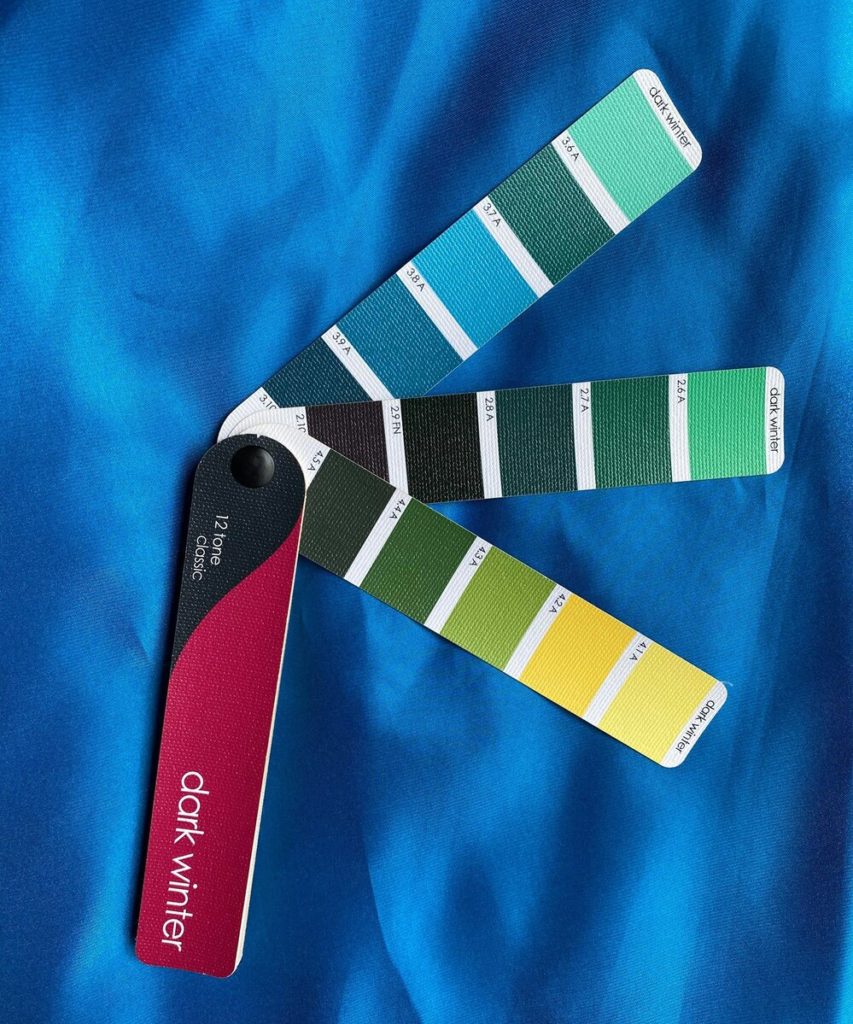
The warm greens that were headed in a bodily fluid direction before are now bringing to mind fresh leaves and stems. The sharpness has disappeared from the light greens and yellows, and I can see them defined but in balance with both the fabric and the other fan colors. In contrast to the pictures of these segments next to the previous blue, I feel resolved looking at these pictures, not confused or questioning. The picture just makes sense so my mind doesn’t have to keep trying to figure it out and can simply relax and enjoy the view.
This blue is both light and bright enough to produce plenty of contrast for a Dark Winter when worn with black (or another dark neutral), but deep and rich enough to also work beautifully well with white (or another light neutral). However, it’s true neither of the blues we’ve harmonized here is as light at the top my client asked about. So here’s one more example, an icy lavender for Dark Winter this time (as I don’t personally own a light blue fabric for this season, though they certainly exist).
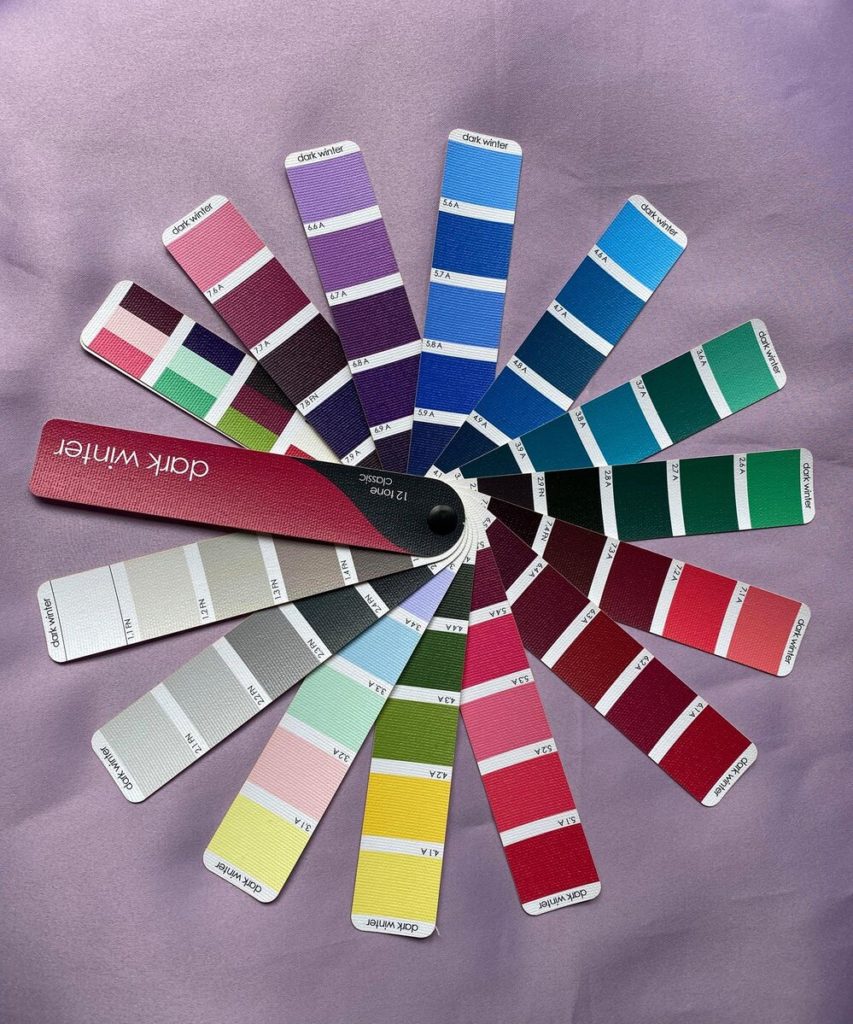
Even though this color is light, it holds its own against the fan just as the previous blue did, balancing both the light and dark colors and allowing the fan to come together and form one picture.
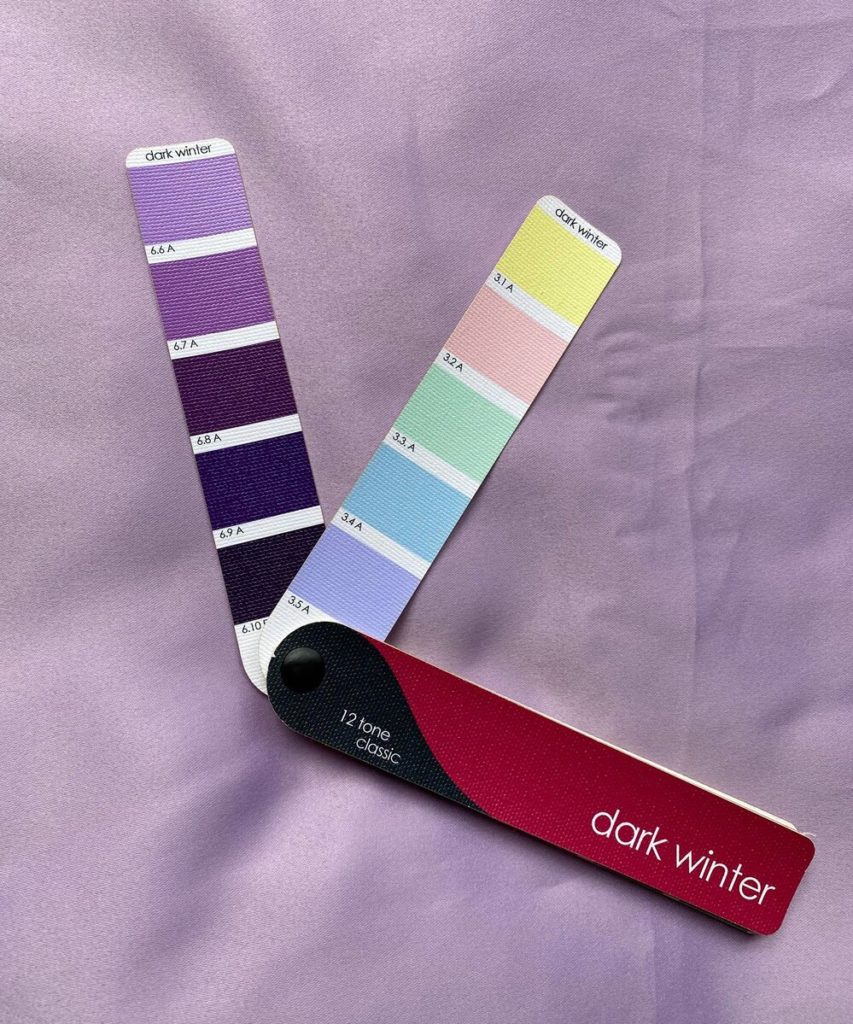
I’ve taken an extra image of this one, to show that colors that harmonize to your palette may not look exactly like anything on your fan. If you were “matching”, you’d never pick this garment, which would be a shame as it’s so incredibly lovely on women of this season. Nevertheless, this drape is beautiful with the other purples that are represented as a swatch. Both expected and unexpected color combinations work. The picture is easy to look at an doesn’t leave me scrambling to make sense of it.
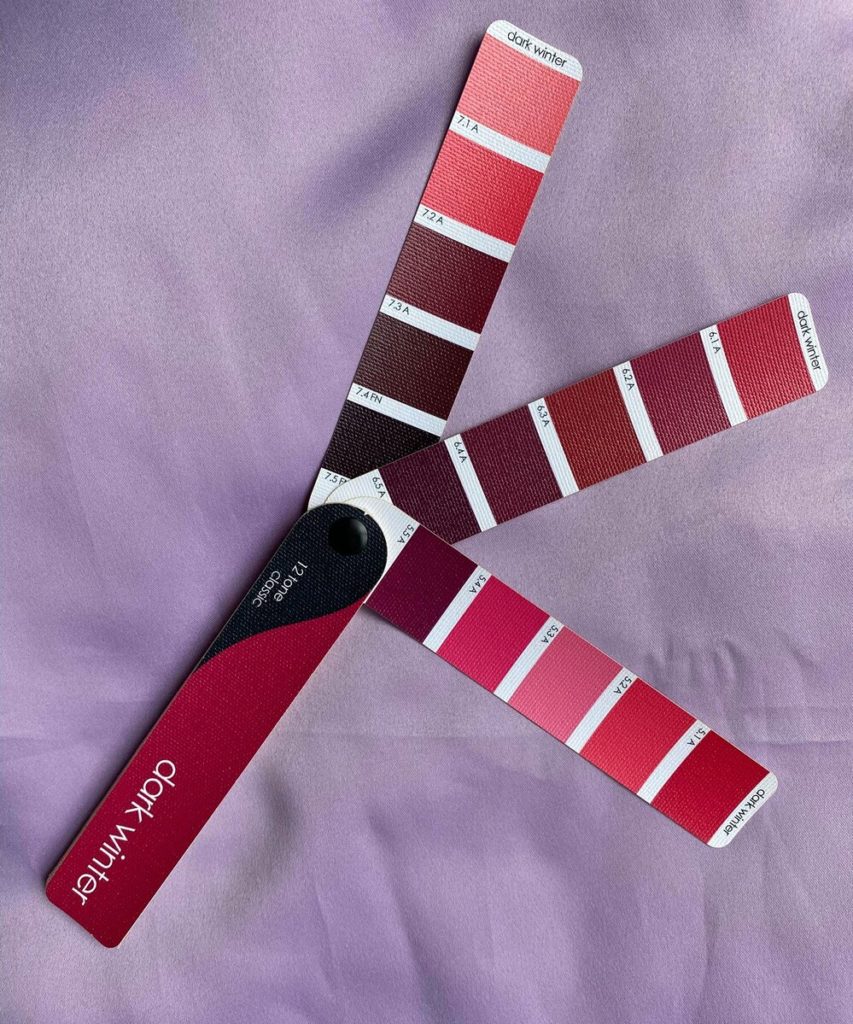
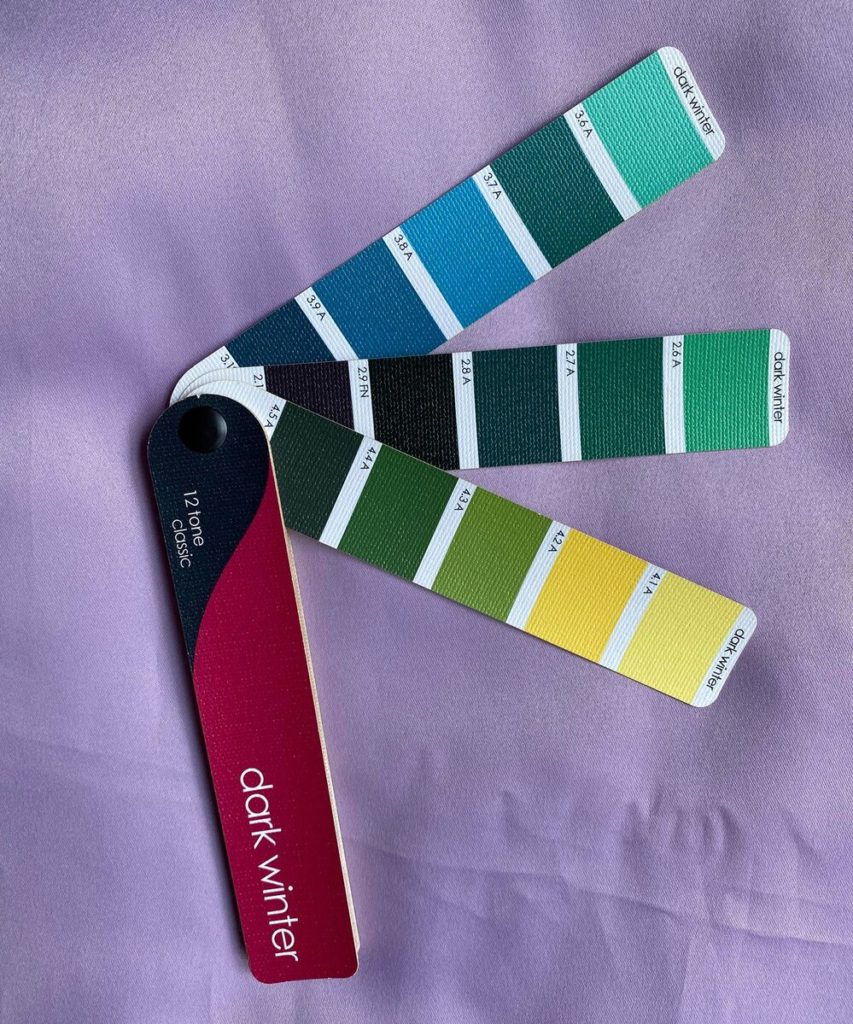
Lastly for consistency’s sake, let’s look at our little fan chunks. Yes, the light shifted slightly as I was photographing this drape, but it’s representative enough to serve the point. This drape performs more similarly next to the fan to the previous blue than to the light blue my client showed me. From this, we can surmise that unlike that fabric, this one is high enough in chroma (aka brightness) and the correct hue (cool-neutral) to maintain harmony with the fan despite being high value (aka light).
It’s worth it
So often we struggle to actually use and get the most value out of the incredible knowledge we invested time and money in acquiring from our color analysis. Harmonizing takes practice, and you won’t always get it right, especially at first. However, the mistakes you make will be far less egregious than those you would make otherwise, and your consistency over time at identifying your colors will skyrocket.
You don’t always have to wear your colors, but wouldn’t it be nice to always know how to recognize them? Learning and practicing proper harmonizing technique is hands down the best way for you to maximize your palette’s potential to guide you to excellent wardrobe decisions and to really understand your season and your own coloring at a deeper level.
So get in that wardrobe and get swatching! 🙂
One last thing
If you’re struggling to work with your palette and identify your colors, I answer questions and give my expert feedback on color in The Society of Extraordinary Style every single week. I’d love for you to join us!
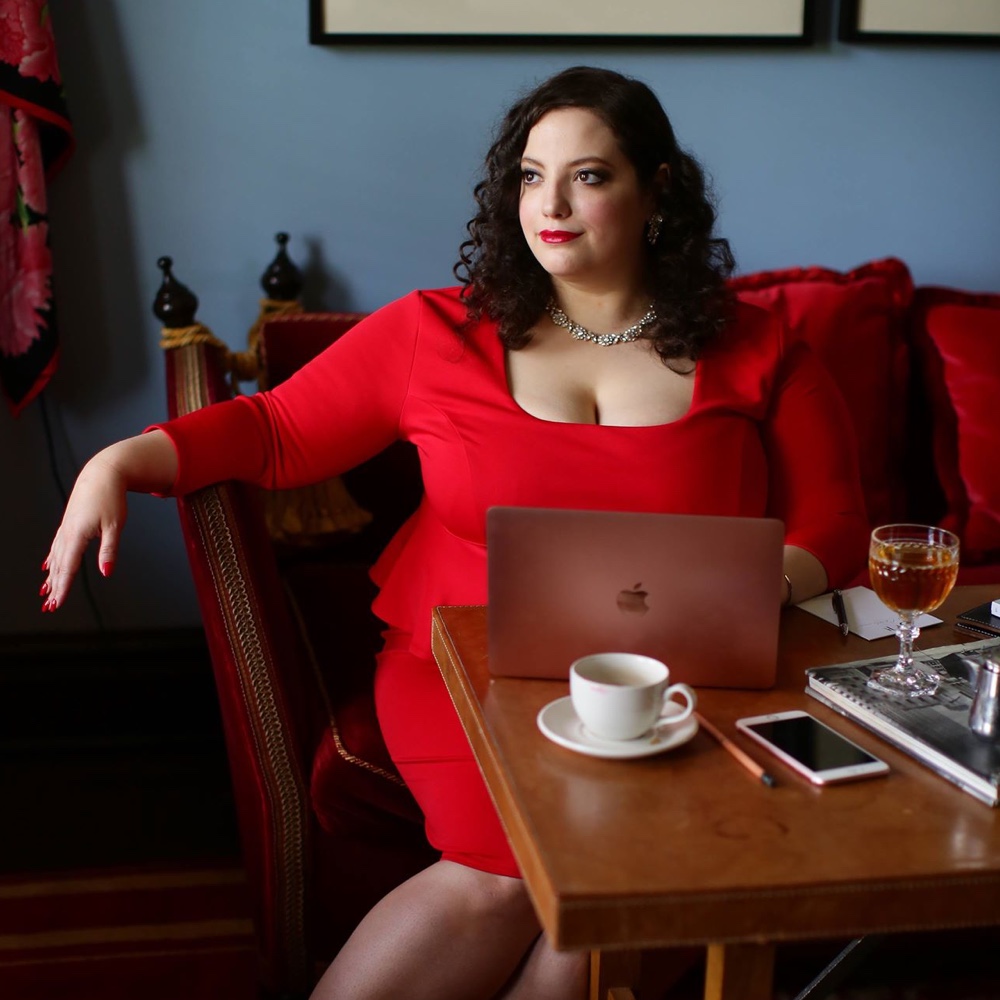
Share this:
- Click to share on LinkedIn (Opens in new window) LinkedIn
- Click to share on Facebook (Opens in new window) Facebook
- Click to share on Pinterest (Opens in new window) Pinterest
- Click to share on X (Opens in new window) X
- Click to email a link to a friend (Opens in new window) Email
- Click to print (Opens in new window) Print

